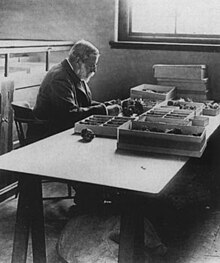Charles Sprague Sargent

Charles Sprague Sargent (April 24,[1] 1841 - March 22, 1927) was an American botanist. He was the first director of the Arnold Arboretum at Harvard University in Boston, Massachusetts and the standard botanical author abbreviation Sarg. is applied to plants he described.
Biography
Sargent was the second son of Henrietta (Gray) and Ignatius Sargent, a Boston merchant and banker who grew wealthy on railroad investments. He grew up on his father's 130 acre (526,000 m²) estate in Brookline, Massachusetts, and attended Harvard College, where he graduated in the Class of 1862. He enlisted in the Union Army later that year, saw service in Louisiana during the American Civil War, and was mustered out in 1865, after which he traveled in Europe for three years.
Having returned to his family's Brookline estate Holmlea, Sargent took over its management as a horticulturist, influenced by his cousin Henry and H. H. Hunnewell of Wellesley. Under his direction, the family estate became a landscape without flower beds or geometric arrangements, but rather a recreation of nature with winding lanes, overhanging branches, and a profusion of trees and shrubbery.
When in 1872 Harvard University decided to establish an arboretum Prof. Francis Parkman at that time a professor of horticulture at Harvard's recently established Bussey Institution, probably suggested his young neighbor Sargent for the position. By the end of 1872, Sargent became the first Director of the Arnold Arboretum, a post he held until his death, and Director of the Botanic Garden in Cambridge (long since given up). On November 26, 1873, he married Mary Allen Robeson (1853–1919). They had two sons and three daughters, one of whom married Guy Lowell.
Even by the standards of Boston society of the early 20th century, Charles Sprague Sargent was unusual. He was colder than even the surrounding, and notoriously chilly, Boston society, had nothing to do with local government, and cared little for the social ills of his era. Rather he was a stern lord of his own arboretum, and always at work during his waking hours. In this career, Sargent came of age as a dendrologist and published extensively. His influence was felt nationally on the conservation of American forests (in particular the Catskills and Adirondacks). At the Arboretum he worked with Frederick Law Olmsted, the Olmsted Brothers from master planning for the roads and plant collections to small details such as the tree plantings on Commonwealth Avenue.
Sargent became professor of arboriculture at Harvard in 1879. He planned the Jesup Collection of North American Woods in the American Museum of Natural History of New York City in 1880. He was chairman of a commission to examine the Adirondack forests and devise measures for their preservation in 1885, and in 1888 became editor and general manager of Garden and Forest, a weekly journal of horticulture and forestry.[1]
His publications include a Catalogue of the Forest Trees of North America (Washington, D. C., 1880); Pruning Forests and Ornamental Trees, translated from the French of A. Des Cars (Boston, 1881); Reports on the Forests of North America (Washington, 1884); The Woods of the United States, with an Account of their Structure, Qualities, and Uses (New York, 1885); and The Silva of North America (12 vols., Boston, 1882-'8).[1]
After Sargent's death in 1927, at an Arbor Day memorial ceremony, Massachusetts Governor Fuller planted a white spruce on the grounds of the Massachusetts State House in his memory, and noted that:
"Professor Sargent knew more about trees than any other living person.
It would be hard to find anyone who did more to protect trees from the vandalism of those who do not
appreciate the contribution that they make to the beauty and wealth of our nation."
See also
References
- ^ a b c
 Wilson, J. G.; Fiske, J., eds. (1900). Appletons' Cyclopædia of American Biography. New York: D. Appleton.
Wilson, J. G.; Fiske, J., eds. (1900). Appletons' Cyclopædia of American Biography. New York: D. Appleton. {{cite encyclopedia}}: Missing or empty|title=(help)

